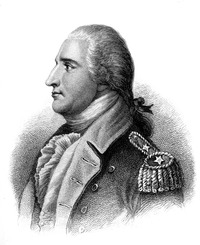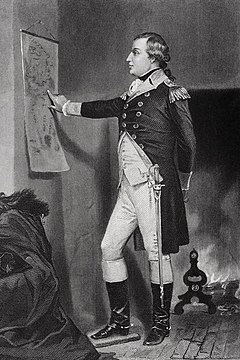In the fall of 1775 the first major military
campaign of the Revolutionary War began, a campaign to capture Quebec Canada in
hopes the French-speaking Canadians would join with the colonists as allies
against the British. Two expeditions
were to take different routes and meet at Quebec. One army under Richard
Montgomery left from Fort Ticonderoga VT, the other from Cambridge, MA commanded
by Benedict Arnold. Studying maps drawn
in 1759, Arnold was convinced he could move his 1,050 volunteers through the
wilderness in three weeks. Among those volunteers was a rifle company from
Cumberland Pennsylvania that included James Warner and Sergeant Joseph
Grier. Also traveling with them were their
wives, 17-year-old Jemima Warner, and Susannah Grier.
One eye witness wrote the following
"There were two women attached to these companies.
One was the wife of Sergeant Grier, of Hendricks's company, a large, virtuous
and respectable woman. The other was Jemima Warner, wife of James Warner, a
private of Smith's company, a man who lagged upon every occasion. These women
having arrived, it was presumed that all the party were up. We were on the
point of entering the marsh when someone cried out, "Warner is not
here!" Another said he had "sat down under a tree a few miles
back." His wife begging us to wait, with tears of affection in her eyes,
ran back to her husband. We tarried an hour. They did not come. Entering the
pond and breaking the ice here and there with the butts of our guns and our
feet, we were soon waist-deep in mud and water. As is generally the case with
youths, it came to my mind that a better path might be found than that of the
more elderly guide. Attempting this in a trice the water, cooling my armpits,
made me gladly return into file. Now Mrs. Grier had got before me. My mind was
humbled, yet astonished, at the exertions of this good woman. Her clothes more
than waist high, she waded before me to the firm ground. No one, so long as she
was known to us, dared intimate a disrespectful idea of her. Arriving at firm ground and
waiting again for our companions, we then set off and, in a march of several
miles, over a scrubby and flat plain, arrived at a river flowing from the east
into Chaudière Lake. This we passed in a bateau.”
Jemima
stayed with her husband until he died, buried his body under leaves, gathered
his equipment and caught up with the troops.
A supposed three week march turned
into six with a loss of almost half of Arnolds’ troops. On
November 8, Arnold arrived at Point Levis, opposite Québec on the St. Lawrence.
When Montgomery approached Québec under a white flag of truce to negotiate,
British cannon opened fire. From a nearby resident, Jemima Warner borrowed a formal
gown and walked into the fort to deliver Montgomery's surrender terms to the
British commander. He not only tore up the offer, he imprisoned Jemima. Five days later he marched her out of the
Fort between two rows of drummers, “drumming her out of the Empire.”
The
battle continued for nearly a month and on December 11, 1775 the British
destroyed a rebel artillery battery at St. Roch killing one man and the 17-year-old
widow, Jemima Warner. Four months later Susannah Grier died in Quebec in an
exchange of gunfire.
The
campaign ended in defeat in January 1776 with Montgomery dead, Arnold wounded
and the Continental Army in retreat.
Jemima Warner was not the first casualty of the Revolutionary War but
she may have been the first woman to die for our cause of independence. Both Jemima and Susannah deserve to be
remembered as heroines of the United States of America.
Sources:
Wikipedia, history channel.com, Military History Magazine, internet sources


No comments:
Post a Comment